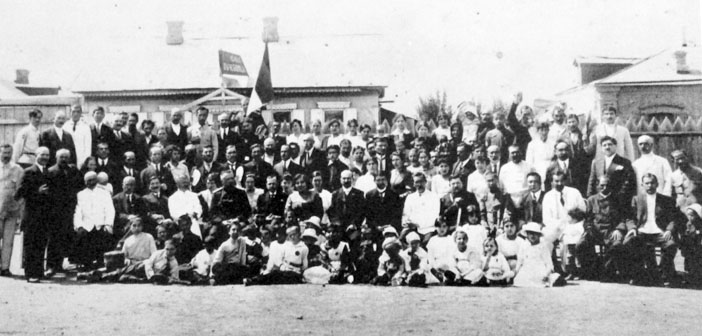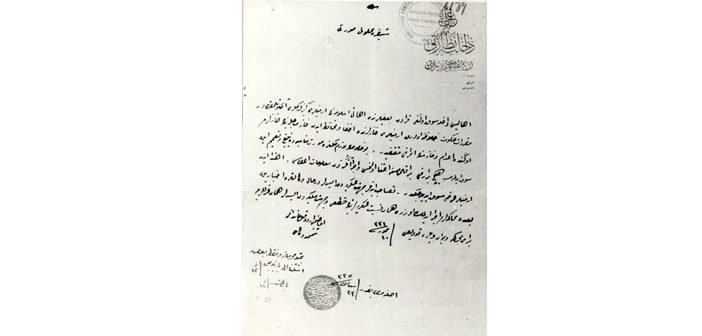Shoah Foundation indexed the testimonies about the Armenian Genocide and added them to the visual history archive of the foundation. Project manager Manuk Avedikyan tells about the project.
Shoah
Foundation in California indexed the testimonies about the Armenian
Genocide and added them to the visual history archive of the
foundation. A total of 400 films containing testimonies about many
incidents from Hamidian massacres to Adana Massacre, from Musa Dagh
Revolt to Defence of Van are opened to public access. Soon, the
collection will be accessible from the universities thanks to an
agreement made with a digital library platform. We talked to Manuk
Avedikyan, who has been executing the project.
What kind of a study has been made in Shoah Foundation on Armenian Genocide? It is said that the foundation has the largest archive concerning genocide and crimes against humanity.
The Visual History Archive (VHA) is the place where all the testimonies are presented with their relevant indexing terms. After indexing the 52,000 Holocaust interviews, the Shoah Foundation initiated their policy of branching out to other crimes against humanity. We have taken in other collections and have shot our own interviews in Rwanda and Nanjing. Regarding other collections outside our own, the Jewish Family and Children's Service (JFCS) has conducted their own Holocaust related interviews, same with the Kigali Genocide Memorial in Rwanda and an organization in Guatemala which will be available in the coming months. The Armenian Film Foundation (AFF) falls into the same paradigm of incorporating another collection of interviews.
I got involved as an indexer first and started last August. Then, I slowly took on the role of project manager.
Could you please talk about the collection of testimonies about the Armenian Genocide?
The AFF's collection is the first Armenian Genocide related collection that has been incorporated into the VHA. It is a documentary film collection and not a methodologically oral history collection. There are two ways of viewing the testimonies on the VHA. The first, is complete access to all VHA testimonies at a VHA access site. There are 55 access sites around the world that have full access and 213 with partial access. No fees. The VHA Online is available to everyone with an internet connection, however it only contains a smaller portion of the videos that are on the VHA. The USC Shoah Foundation has made a recent agreement with ProQuest that would broaden access of the VHA to more universities.
What should we expect to see in your archive consisting of testimonies about the Armenian Genocide?
AFF Director Hagopian and his team traveled to Australia, Canada, Armenia, Syria, Lebanon, Greece, Germany, England, and France between 1972-2013 to film interviews. However, the majority of the interviewees are Armenian survivors who resided in all corners of the United States.
In addition, there are many foreign witnesses, including missionaries or missionary family members along with diplomats; some aid givers, mainly Arabs from Syria around Der Zor and Qamishli; Yezidi survivors from Armenia (mostly from Digor, Kars, Surmeli); Greek survivors of the Great Fire of Smyrna and a small handful of the Great Exchange; scholars like Vahakn Dadrian, Taner Akcam, Richard Hovannisian, Raymond Kevorkian, Hilmar Kaiser; Armenian fedayis or volunteers on the Caucasian front or for the French legion; many testimonies about the Musa Dagh resistance; Islamisized Armenian families from Syria; and descendants of Armenian Genocide survivors in the US in order to bring light to how the American-Armenian community viewed the Genocide issue in the 1970's. There are also over a dozen interviews conducted in Turkish by Armenian Genocide survivors. You can also watch interviewees who survived the Hamidian massacres of 1894-96 and discuss their experiences. Many of them also survived the Armenian Genocide or left to America before 1915. Hagopian made a film called the "Germany and the Secret Genocide," there is a lot of footage from various historians that discuss various aspects of German complicity in the Armenian Genocide.
Is it true that this is the largest collection of the testimonies about the Armenian Genocide?
The Armenian Film Foundation's collection is the largest Armenian Genocide 'Film' collection. Other collections do not contain this many 16 mm film interviews. There are bigger collections, like the Zoryan's Institute's collection which reaches nearly 800 in video. Richard Hovannisian's UCLA Armenian Genocide Oral History Project has around 800 as well, but in audio only, not video. There are other smaller collections all around the world. We have nearly 400 interviewees that were shot, but 334 interview profiles because of over 20 group interviews that were incorporated in Hagopian's filming process.
Can you talk about the process of indexing?
Indexing is one of the most important components of the work in the USC Shoah Foundation. It's like an index in the back of a book for video testimonies and it was started with the original 52,000 Holocaust testimonies collected with the initiative of Steven Spielberg. We input indexing terms like "stealing," "mass execution," "Adana Massacres (1909)," or "Van (Turkey)" in order for people to access the very minutes (page) the topic came up within the testimony.
Did you learn something new during your indexing work? What are your plans now?
I have learned a lot. I have indexed nearly 200 of the interviews and have come close to reviewing all the rest.
Finding many of the villages discussed in the testimonies is an adventure for me, especially when few clues are given. Knowing some basic Turkish often helps me immensely for finding geographic places. Sevan Nisanyan's map is of course a go to source but is never just enough.
I have learned a bit more how the deportation camps along the railroad function.
The level of dialects are incredible in this collection. It represents Western Armenian dialects in a very wholesome way and is an audible preservation of those dialects that are now dead due to Genocide and standardized Western Armenian education.
We are still involved in translating the interviews from Armenian into English. Turkish, Arabic, Greek and Kurdish interviews will also be translated and subtitled into English.





